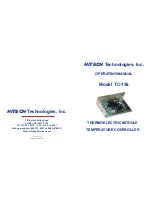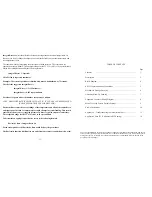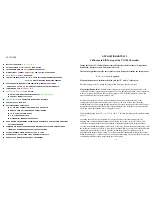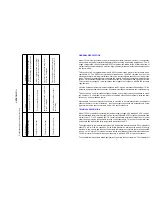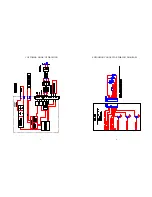
value provides for manual control of the output, either polarity, from 0% to 100% of load power.
Proportional bandwidth (P) in degrees, integral reset (I) in repeats per minute, and the derivative
rate (D) in minutes may be configured for P, PI, PD, or PID control. In addition, a deadband control
(on/off) with an adjustable hysteresis may be selected. Differential temperature control is offered
when two input sensing thermistors are chosen.
A control temperature range of –20°C to 100°C (TS67 series probe) or -40°C to 70°C (TS141series
probe) is standard when using an HiTECH thermistor sensor for the PC’s primary set temperature.
Additional external set temperature input types may be selected. They include a remote set tem-
perature potentiometer, a 0 to 5 VDC signal, and a 0 to 20 ma current loop. These secondary inputs
are used to define and “map” the secondary input to an adjustable temperature range. Differential
set temperature control may also be selected from this configuration menu. All temperatures may be
consistently displayed in °C. or °F.
Differential control is accomplished by selecting the primary set temperature with the second
thermistor input and establishing the offset with the computer set temperature. The unit will
control the differential between Input 2 (reference temperature) and Input 1 (actual system tem-
perature).
Two types of control output modes may be selected. This determines the direction of the current
flow through the thermoelectric module during the heat cycle. This current flow may be from Wire
Point WP1 (+) to Wire Point WP2 (-). Alternatively, this current flow may be reversed from WP2
(+) to WP1 (-) as selected in the configuration menu.
Several alarm types may be selected which provide a 5 VDC output, rated for 25 ma of current.
They consist of no alarm function, tracking alarm, and fixed value alarm. Alarm set temperature
values are entered in the setup menu. The computer-controlled selection is available for addi-
tional embedded controller input/output options. The alarm setup menu also provides for selec-
tion of an alarm latching condition. The alarm sensor may be either the control temperature
sensor or a secondary thermistor sensor.
The various alarms have the ability to determine the status of the output power to the thermoelec-
tric module or auxiliary heater. Power may be maintained during an alarm condition or the main
power may be shut down.
3
24. NOTE: Refer to the Menu Tree in this manual for the factory default settings for the following parameters.
25. The FIXED SET TEMP is the set temperature value entered in degrees. This temperature is one within the range
of the input sensor or the limits of low and high set ranges from the controller configuration setup. The COMPUTER
CONTROL selection in the CONTROL TYPE configuration provides a fixed percentage of power to the load. This
power resolution with an entry of 0.0 is equal to 0% power and +12.0 equals 100% power and -12.0 equals -100%
power.
26. PROPORTIONAL BANDWIDTH is the temperature band in which 0% to 100% power will be applied to the load.
The acceptable bandwidth values that may be entered are 1° to 100°.
27. INTEGRAL GAIN shifts the proportional bandwidth with respect to the set point to compensate for droop. This
value is expressed in repeats per minute and the acceptable values that may be entered are .01 to10 repeats per
minute.
28. DERIVATIVE GAIN senses the rate of rise or fall of the system temperature and adjusts the cycle time of the
controller to minimize overshoot or undershoot. This value is expressed in cycle rates per minute and the
acceptable values that may be entered are .01 to 10 cycles per minute.
29. CONTROL DEADBAND is the temperature band where the controller is turned on and off by either rising or
falling temperatures where no heating or cooling takes place. This band is expressed in °F. and the acceptable
values that may be entered are 0.1°F. to 100°F.
30. Review the tuning parameters for correctness and then select the Send Box Values button to download these
constants to the controller.
31. The CALIBRATE box provides additional variables that can be used to fine tune your system’s operation. You
may want to try controlling with the initial settings prior to entering values in this section.
32. INPUT 1 OFFSET is a manual method of compensating for the sensor 1 temperature and actual control temperature.
33. INPUT 2 OFFSET is a manual method for compensating for the sensor 2 temperature and actual temperature.
34. HEAT SIDE MULTIPLIER is a 0.01 to 2.00 numerical multiplier that compensates for the non-symmetrical response
of the thermoelectric module between the heat and cool modes.
35. If you have entered values in the CALIBRATE box and they are the desired settings, select the Send Box Values
button to download these constants to the controller.
36. Initial set-up of your Model TC-136 controller is complete.
12

